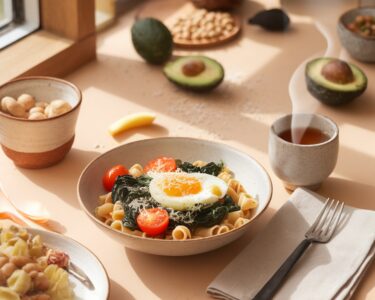The “girl dinner” trend has transformed how millions approach evening meals, with TikTok users proudly showcasing casual snack-based alternatives that replace traditional sit-down dinners. This shift to snack drawer dinner meal chaos reflects broader lifestyle changes, with Americans now obtaining over 25% of their daily calories from snacks and many converting these grazing sessions into full-fledged meals.
Key Takeaways
- Most people now snack 2-3 times daily, often turning these snack sessions into complete meals with combinations like cheese and crackers with fruit or hummus with veggies.
- The typical snack-based dinner contains concerning nutritional metrics: approximately 800mg of sodium and 20g of sugar while providing less than 5g of fiber.
- Americans currently average just 15g of fiber daily, significantly below the recommended 25-38g needed for optimal health.
- Creating balanced snack plates should focus on three key nutrients: protein (15-20g), fiber (5-10g), and healthy fats to prevent energy crashes.
- Smart snacking options include whole foods such as hard-boiled eggs, Greek yogurt, hummus with whole wheat pita, and edamame pods that provide substantial protein and fiber.
The Rise of Snack-Based Dinners
I’ve noticed how the social media-driven “girl dinner” phenomenon has completely changed mealtime habits. Instead of cooking traditional dinners, people now proudly display their random assortments of snacks on TikTok as legitimate evening meals. This casual approach to dinner reflects a major shift in how Americans eat — we’re now getting a quarter of our daily calories from snacks, with many people turning simple snacking into their main meals.
The Nutritional Concerns
The data shows most folks snack 2-3 times each day, often combining items like cheese, crackers, and fruit to create makeshift dinners. But there’s a nutritional cost to this convenience. The average snack-based dinner packs about 800mg of sodium and 20g of sugar while offering minimal fiber — typically less than 5g. This creates a serious fiber gap, as most Americans consume only 15g daily, far short of the 25-38g health experts recommend.
Building a Balanced Snack Plate
Nutrient Priorities
To transform random snacking into balanced nutrition, I focus on three essential components: adequate protein (15-20g), sufficient fiber (5-10g), and healthy fats. This combination prevents the energy crashes that often follow carb-heavy snack sessions.
Recommended Smart Snacking Options
- Hard-boiled eggs
- Greek yogurt
- Hummus with whole wheat pita
- Edamame pods
These foods deliver substantial protein and fiber without excessive processing or added sugars, making them excellent choices for those embracing the snack-based dinner trend.
The Rise of “Girl Dinner”: Why Everyone’s Eating Straight from Their Snack Drawer
Snack Drawer Dinner Meal Chaos Takes Over Social Media
Let’s face it – traditional sit-down dinners are becoming less common as our lives get busier. The “girl dinner” phenomenon has exploded on TikTok, racking up billions of views as people share their casual dinner routines straight from their snack drawers. This shift perfectly captures how snack drawer dinner meal chaos has become the new normal for many of us.
I’ve noticed more people embracing this casual approach to evening meals, creating aesthetic snack plates from whatever they find in their cabinets. The numbers back this up – Americans now get over 25% of their daily calories from snacks, marking a major change in eating habits.
How Snacking is Replacing Traditional Meals
The snack drawer dinner meal chaos isn’t just a trend – it’s transforming how we eat. Most people now snack 2–3 times daily, often turning these snack sessions into full meals. I’ve seen countless snack routines emerge that combine different items into satisfying meals:
- Cheese and crackers paired with fruit
- Mixed nuts and dried fruit with dark chocolate
- Hummus with veggie sticks and pita chips
- Greek yogurt topped with granola and honey
This grazing style of eating fits perfectly with today’s fast-paced lifestyle. Instead of spending time cooking elaborate meals, many people are creating quick snack combinations that satisfy their hunger while maintaining flexibility in their schedule.
The snack drawer dinner trend reflects a broader cultural shift away from strict mealtimes. Whether it’s working late, studying, or just preferring to eat smaller portions throughout the day, this casual approach to dining is here to stay. By keeping a well-stocked snack drawer, you’re always prepared to put together a satisfying meal – no cooking required.
The Hidden Cost of Choosing Snacks Over Meals
Breaking Down Snack Drawer Dinner Meal Chaos
I’ve noticed a concerning trend where snack drawer dinner meal chaos has become the new normal for busy professionals. The numbers paint a stark picture – a typical snack-based dinner packs a whopping 800mg of sodium and 20g of sugar, while delivering less than 5g of fiber. That’s a nutritional red flag I can’t ignore.
Let’s face it – those quick trips to the aesthetic snack plate might seem convenient, but they’re creating a significant nutritional gap. While Americans currently average just 15g of fiber daily, we should be aiming for 25–38g for optimal health.
The Real Impact of Snack Drawer Dinner Meal Chaos
The rush to grab whatever’s available from our snack drawer routine comes with serious consequences. Ultra-processed foods making up more than 20% of daily calories can lead to increased health risks. I’ve found that many people don’t realize their quick dinner alternatives are costing them more per nutrient than home-cooked meals.
Here are the common culprits I see in most snack drawers:
- Processed chips and crackers high in sodium
- Cookies packed with added sugars
- Cheese sticks lacking complete nutrition
- Processed meat sticks with preservatives
- Granola bars masquerading as healthy options
The time crunch is real – 40–60% of people point to lack of time as their main reason for choosing quick food options. But creating a proper balanced meal box doesn’t have to be complicated. A balanced meal provides 25–30g of protein and 10–15g of fiber, giving your body the fuel it actually needs.
The snack drawer dinner meal chaos might seem like a solution to busy schedules, but I’m seeing more people realize its impact on both their health and wallet. By taking just 15 minutes to prep simple meals, you can dodge the nutritional pitfalls of relying solely on snacks for dinner.
Making Peace with the Snack Plate: Better Choices for Busy Days
Smart Solutions for Snack Drawer Dinner Meal Chaos
I’ve discovered that transforming snack drawer dinner meal chaos into a nutritious eating experience isn’t as complicated as it seems. By focusing on three key nutrients – protein, fiber, and healthy fats – I can create satisfying meals that keep me energized.
For a balanced snack plate that actually fills me up, I aim for 15-20g of protein and 5-10g of fiber per meal. This combination helps prevent the dreaded energy crash that often follows a pure carb snack fest. Just like creating a satisfying sad girl dinner, it’s about making intentional choices with what’s available.
Here are my go-to options for building a better snack plate:
- Hard-boiled eggs (6g protein each)
- Greek yogurt cups (15-18g protein)
- Single-serve hummus with whole wheat pita (8g protein, 4g fiber)
- Edamame pods (11g protein, 5g fiber per cup)
- Mixed nuts and dried fruit (varied protein and fiber)
Creating Balance During Snack Drawer Dinner Meal Chaos
I’ve found success using the plate method, even when pulling together a quick bento box style meal. I divide my plate into three sections: protein-rich foods, fiber-packed carbohydrates, and healthy fats. This approach helps me avoid the temptation to grab only chips or crackers.
Mindful portioning plays a crucial role in preventing blood sugar spikes. I’ve learned that creating a visually appealing snack plate can make the meal more satisfying. By arranging items thoughtfully, similar to putting together a soft girl snack routine, I’m more likely to eat slowly and feel satisfied.
When snack-based dinners become a regular occurrence, I pay extra attention to potential nutritional gaps. I keep single-serve portions of nuts, seeds, and dried fruits in my drawer to boost the nutritional value of my impromptu meals. Choosing whole or minimally processed options whenever possible helps ensure I’m getting the most nutritional bang for my buck, even during those hectic evenings when a traditional dinner isn’t happening.
What started as an innocent attempt at making a low-effort dinner turned into full-blown mayhem when the kids raided the pantry for their own “creative” choices, just like in this hilarious family moment.
Sources:
Harvard T.H. Chan School of Public Health website
Mayo Clinic Health System website
U.S. Department of Agriculture (USDA), Economic Research Service
Centers for Disease Control and Prevention (CDC), National Center for Health Statistics








